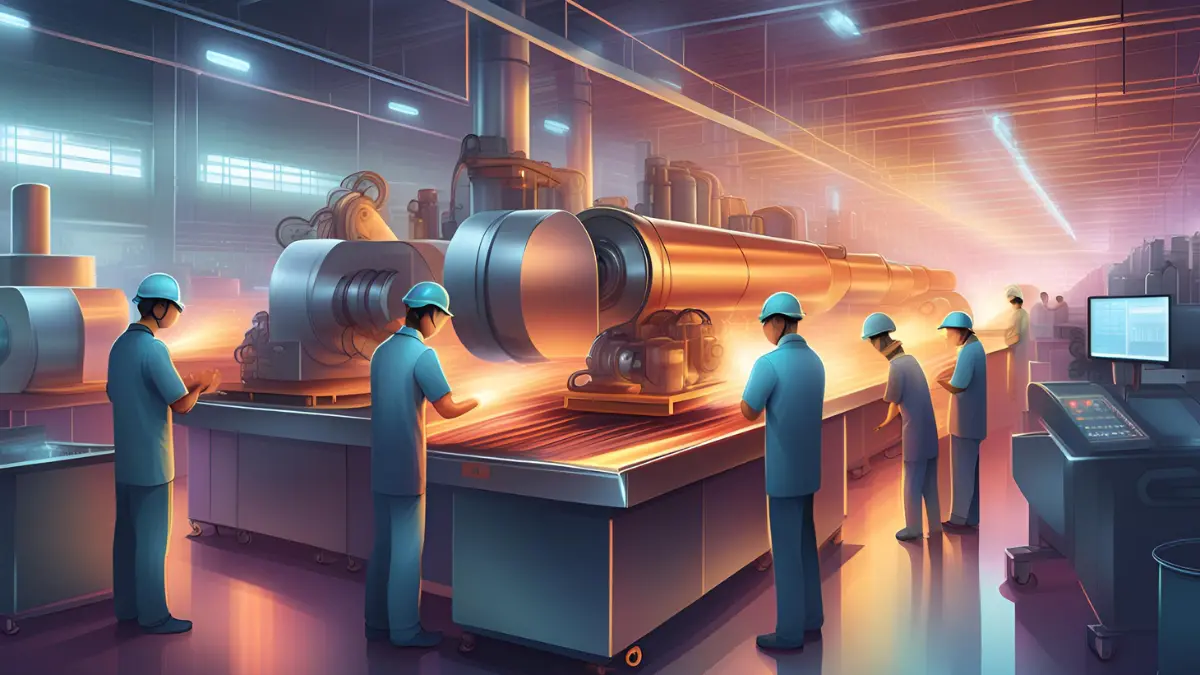Efficient replenishment is crucial for optimizing supply chain efficiency and ensuring products are readily available when needed. In Singapore, businesses are increasingly focusing on replenishment strategies to streamline their operations and meet the ever-changing market demands.
In this article, we will explore the concept of replenishment and its relevance to Singapore’s manufacturing landscape. Discover how implementing effective replenishment strategies can drive operational excellence and boost competitiveness in the dynamic market.
Supply chain efficiency plays a vital role in sustaining business growth and meeting customer expectations. By adopting intelligent replenishment strategies, businesses in Singapore can minimize costs, reduce waste, and improve overall productivity.
Join us on this journey to unlock the key insights into replenishment strategies and witness how they have transformed the supply chain landscape in Singapore.
Key Takeaways
|
Table of Content:
Table of Content

Make to Assemble (MTA) Manufacturing: Achieving Balance and Flexibility
Make to Assemble (MTA) manufacturing is a strategy that strikes a balance between Make to Stock (MTS) and Make to Order (MTO) approaches. This strategy has gained significant popularity in Singapore’s manufacturing landscape due to its ability to efficiently meet customer demands while maintaining flexibility in production.
MTA manufacturing involves producing components or subassemblies in advance and then assembling them into finished products based on customer orders. This approach allows manufacturers to reduce lead times and inventory costs while ensuring the availability of customized products.
In contrast to MTS, where finished goods are produced without specific customer orders, and MTO, where products are manufactured only after receiving customer orders, MTA offers a middle ground. It combines the advantages of MTS, such as shorter production lead times, with the flexibility of MTO, allowing for customization and variation in the final assembly process.
By implementing MTA manufacturing, companies in Singapore can optimize their supply chain efficiency and respond effectively to dynamic market demands. This strategy enables them to strike a balance between inventory management and customer satisfaction, reducing excess stock while ensuring timely product delivery.
MTA manufacturing is particularly well-suited for industries with a high degree of product customization or variations in demand. By adopting this strategy, manufacturers can streamline their operations, enhance productivity, and maximize their competitiveness in the global market.
Next, we will explore the advantages of MTA manufacturing for Singapore’s manufacturing sector due to replenishment, and how it can enhance operational efficiency and drive business success.
Advantages of MTA for Singapore’s Manufacturing Sector
Implementing Make to Assemble (MTA) manufacturing in Singapore offers significant benefits to the manufacturing sector. By adopting MTA strategies, businesses can enhance operational efficiency, reduce inventory costs, improve customer satisfaction, and gain flexibility in production, ultimately strengthening their competitiveness in the Singapore manufacturing sector.
One of the key advantages of MTA is its ability to minimize inventory costs. With MTA, manufacturers can avoid overstocking by producing goods only when they are needed for assembly. By reducing excess stock, businesses can optimize their inventory management and allocate resources more effectively, leading to cost savings and improved financial performance.
Furthermore, MTA enables manufacturers to meet customer demand promptly and consistently, resulting in enhanced customer satisfaction. By producing products based on specific customer orders, businesses can ensure that the right products are available when needed, minimizing lead times and avoiding stockouts. This responsiveness to customer needs can significantly improve customer loyalty and brand reputation.
The flexibility in production offered by MTA is another valuable advantage for Singapore’s manufacturing sector. MTA allows businesses to quickly adapt to market changes and fluctuations in demand. By producing goods based on customer orders rather than forecasting future demand, manufacturers can avoid the risk of producing excess inventory or being caught off guard by sudden changes in customer preferences or market conditions.
By implementing MTA manufacturing, Singaporean manufacturers can enhance their operational efficiency and competitiveness, enabling them to thrive in today’s dynamic business environment.
Implementing MTA manufacturing in Singapore offers several advantages for the manufacturing sector. These include reduced inventory costs, improved customer satisfaction, and flexibility in production. By adopting MTA strategies, businesses can enhance their operational efficiency and competitiveness in the Singapore manufacturing sector.
Implementing MTA in Manufacturing: Key Steps for Success
Implementing Make to Assemble (MTA) manufacturing in your production process requires careful planning and execution of replenishment. By following the key steps outlined below, you can effectively implement MTA and reap the benefits it offers in terms of supply chain efficiency and operational excellence.
1. Demand Planning: Begin by analyzing customer demand patterns and forecasting future demand. This step will help you determine the quantity and timing of production to meet customer orders.
2. Production Scheduling: Develop a production schedule that aligns with the demand forecast. Ensure that materials and resources are available when needed to avoid production delays.
3. Final Assembly: Organize the final assembly process to efficiently integrate various components into finished products. Focus on minimizing lead times and optimizing workflow to streamline the assembly process.
Implementing MTA manufacturing requires coordination and collaboration across different departments, including procurement, production, and logistics. Effective communication and information sharing are crucial to ensure a smooth transition to the MTA approach.
By implementing MTA manufacturing in your production process, you can achieve greater flexibility, reduce inventory costs, and meet customer demand more efficiently. This approach is particularly beneficial for manufacturers in Singapore, where supply chain efficiency is vital in a competitive manufacturing landscape.
Challenges and Solutions in MTA Implementation
While implementing Make to Assemble (MTA) manufacturing in your operations can bring numerous benefits, it is important to be aware of the challenges that may arise during the implementation process. By identifying these challenges and implementing strategic solutions, you can ensure a smooth and successful MTA implementation in your Singapore manufacturing business.
Cost of Implementation
One of the common challenges in MTA implementation is the initial cost involved. Upgrading existing infrastructure or implementing new technologies can require a significant investment. However, the long-term benefits such as reduced inventory costs, improved operational efficiency, and increased customer satisfaction often outweigh the initial expenses. It is crucial to carefully evaluate the costs and benefits before making any investment decisions.
Integration with Existing Infrastructure
Integrating MTA manufacturing with your existing infrastructure and systems may pose challenges. It requires seamless integration of various processes, including demand planning, production scheduling, and final assembly. To overcome this challenge, consider leveraging technologies such as Enterprise Resource Planning (ERP) systems that provide comprehensive integration capabilities. These systems can help streamline operations and facilitate smooth MTA implementation.
Data Accuracy
Data accuracy is essential for effective MTA implementation. Accurate and timely data is needed for demand planning, inventory management, and production scheduling. However, maintaining data accuracy can be a challenge, especially when dealing with large datasets. Implementing automated data collection systems and regular data audits can help improve data accuracy and minimize errors in the MTA process.
Change Management
Implementing MTA manufacturing often requires introducing significant changes in processes and workflows. This can lead to resistance from employees and stakeholders who may be accustomed to existing practices. To address this challenge, effective change management strategies should be in place. This includes providing training and education to employees, communicating the benefits of MTA implementation, and involving team members in the decision-making process.
To address these challenges effectively, it is crucial to develop a comprehensive MTA implementation plan that takes into consideration the specific needs and requirements of your Singapore manufacturing business. By addressing these challenges head-on and implementing strategic solutions, you can ensure a successful MTA implementation that enhances supply chain efficiency and improves operational performance.
Success Stories: MTA Implementation in Singapore
Real-world examples of Singaporean manufacturers who have successfully implemented Make to Assemble (MTA) manufacturing can serve as inspiration for other businesses. These success stories showcase the effectiveness of MTA strategies and the benefits realized in the Singapore manufacturing sector.
One notable success story is Company XYZ, a leading electronics manufacturer in Singapore. They implemented MTA manufacturing to optimize their production processes and improve supply chain efficiency. By strategically balancing the production of sub-assemblies with final assembly, Company XYZ was able to reduce inventory costs while ensuring on-time delivery of finished products to customers. This implementation strategy resulted in a significant improvement in their operational performance.
Another example is Manufacturer ABC, a renowned automotive parts supplier in Singapore. They adopted MTA manufacturing to address the challenges of demand variability and customization. By implementing flexible production lines and leveraging real-time demand data, Manufacturer ABC was able to quickly respond to changing customer requirements and minimize lead times. This implementation approach led to increased customer satisfaction and a distinct competitive advantage in the market.
These success stories highlight the effective implementation strategies employed by Singapore manufacturers to realize the benefits of MTA manufacturing. By carefully analyzing their production processes, implementing flexible production lines, and leveraging data-driven insights, these manufacturers have achieved remarkable improvements in supply chain efficiency and customer satisfaction.
Through these success stories, Singapore manufacturers can gain valuable insights into the practical application of MTA manufacturing and explore how it can be tailored to their specific business needs. By embracing MTA strategies, businesses in Singapore have the opportunity to optimize their operations, reduce costs, and stay ahead in an increasingly competitive manufacturing landscape.
Strategies for Optimizing MTA Manufacturing
To fully optimize Make to Assemble (MTA) manufacturing processes and achieve supply chain efficiency, manufacturers in Singapore can implement various strategies. Streamlining operations through effective inventory management and supplier collaboration is key to enhancing supply chain efficiency. By establishing strong relationships with suppliers, you can ensure a reliable flow of materials, reduce lead times, and minimize inventory holding costs.
In addition, leveraging technology and automation plays a crucial role in optimizing MTA manufacturing in Singapore. Implementing Enterprise Resource Planning (ERP) systems allows for better visibility and control over inventory, production, and order fulfillment. The use of Internet of Things (IoT) devices enables real-time monitoring and data collection, improving operational efficiency and reducing downtime.
Risk management is another vital aspect of MTA manufacturing. Demand variability, supply chain disruptions, and product customization can all pose risks to the manufacturing process. By implementing robust risk management strategies, such as predictive analytics and contingency planning, manufacturers can mitigate these risks and ensure uninterrupted operations.
Looking ahead, future trends in MTA manufacturing present exciting opportunities for Singaporean manufacturers. Emerging technologies like AI-driven demand forecasting and 3D printing offer the potential for even greater efficiency and customization. By staying informed about these trends and embracing technological advancements, manufacturers can position themselves at the forefront of the industry and maintain a competitive edge in the ever-changing manufacturing landscape of Singapore.
Conclusion
In conclusion, Make to Assemble (MTA) manufacturing offers a strategic advantage by balancing the benefits of Make to Stock and Make to Order approaches on replenishment, enhancing flexibility and customer satisfaction in the competitive manufacturing sector of Singapore. By adopting MTA, companies can efficiently manage inventory replenishment, reduce lead times, and meet specific customer demands with customized products. For businesses looking to implement or improve their MTA strategy, exploring advanced ERP solutions like those offered by HashMicro could provide the necessary tools to streamline operations and boost productivity. Experience these benefits firsthand by signing up for a free demo of HashMicro’s innovative ERP systems today.















